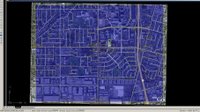1. Intermingle/Gathering data from various other Coordinate Systems seamlessly.
2. Transfer Civil Data from Civil 3D to Google Earth more accurately (vs. UTM or Lat/Long data)
The steps as outline in HELP are as follows:
1. In Toolspace, on the Settings tab, right-click the drawing and click Edit Drawing Settings.
2. In the Drawing Settings dialog box, click the Units and Zone tab.
3. Under Drawing Units, select either Feet or Meters.
4. Under Angular Units, select an angle format.
5. Under Scale, select a scale.
6. From the Categories list, select a zone category.
7. Categories include Lat/Longs, US states, and so on.
When you select a category, the Available Coordinate Systems list displays all the defined zones in that category.
Tip: If you know the coordinate system (CS) code for a zone, you can enter it in the CS Code text box and click OK to select the zone.
8. Select the zone.
9. Click OK.
I did not know what the ground coordinates were for the location of the KETIV Technologies offices here in Fullerton, CA. I did know that we were in NAD83 California State Planes, Zone VI, US Foot (AKA. CA83-VIF). By assigning this to a drawing and some trial and error with the "Publish to Google Earth..." command I now know that the center of our offices are at...
X = 6064787.1131 Y = 2265863.0846 or
Northing = 2,265,863 Easting = 6,064,787
By assigning the Category and Coordinate System my drawing now knows where in the world it is.

Note: Obviously, if all we know is an assumed coordinate location this is NOT possible.

No comments:
Post a Comment